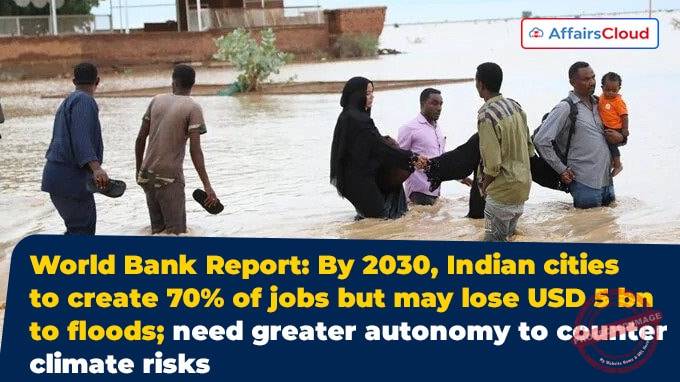 In July 2025, the World Bank Group (WBG) released its latest report titled ‘Towards Resilient and Prosperous Cities in India’, prepared in partnership with the Ministry of Housing and Urban Affairs (MoHUA), Government of India (GoI). The report has projected that Indian cities hold huge potential as centres of economic growth, with 70% of new jobs coming from cities by 2030.
In July 2025, the World Bank Group (WBG) released its latest report titled ‘Towards Resilient and Prosperous Cities in India’, prepared in partnership with the Ministry of Housing and Urban Affairs (MoHUA), Government of India (GoI). The report has projected that Indian cities hold huge potential as centres of economic growth, with 70% of new jobs coming from cities by 2030.
- Annual pluvial flood-related losses are expected to increase from currently estimated USD 4 billion to USD 5 billion by 2030 and between USD 14 and USD 30 billion by 2070, if cities don’t invest in adoption.
- The report is based on analytical work conducted between September 2022 and May 2025 and is supported by the Global Facility for Disaster Reduction and Recovery (GFDRR) including its City Resilience Program.
Key Findings:
i.India’s urban population is expected to almost double by 2050 to 951 million and over 144 million new homes will be required by 2070.
ii.The report warns that Indian cities face increasing vulnerability to climate risks like floods and heatwaves, necessitating investments exceeding USD 2.4 trillion by 2050 and USD 10.9 trillion by 2070 to develop resilient, low-carbon infrastructure.
iii.The report has studied 24 Indian cities, with a special focus on cities like: Chennai (Tamil Nadu, TN), Indore (Madhya Pradesh, MP), New Delhi (Delhi) ,Lucknow (Uttar Pradesh, UP), Surat (Gujarat) and Thiruvananthapuram (Kerala).
- The report has further identified cities like: New Delhi, Chennai, Surat and Lucknow, are most exposed to urban heat island effects and flood risks, particularly due to settlement expansion into vulnerable areas.
- It cautioned that timely action is required for cities to deal with impacts from extreme weather events and help to avert huge economic losses in future.
iv.The report noted that only 10 out of 126 cities assessed under the Climate Smart Cities Framework have carried out flood risk assessments and created flood management plans.
v.The report has outlined several recommendations for national and state-level interventions like: implementing programs to address extreme urban heat and flooding which includes better regulation of storm water, green spaces, installation of cool roofs, and effective Early Warning Systems (EWSs).
Key Projections related to Heat Stress:
i.Intense heat waves and urban heat island effects were already causing temperatures in city centres to increase by over 3-4 degrees over surrounding areas.
ii.The report revealed that exposure to dangerous heat levels increased by 71% in India’s 10 largest Indian cities between 1983 and 2016, increasing from 4.3 billion to 10.1 billion persons-hours per year.
iii.As per the report, heat-related deaths are expected to double i.e. to over 3 lakh annually by 2050.
- The report cautioned that if greenhouse (GHG)emissions continue at current levels, annual heat-related deaths are expected to increase from 1.44 lakh to over 3.28 lakh by 2050.
iv.The report has estimated that heat mitigation alone could increase India’s Gross Domestic Product (GDP) by a maximum of 0.4% and can save over 1.3 lakh lives annually from heat impacts by 2050.
Cities Need More Funds as Flood Losses Rise:
i.India currently spends only 0.7% of its Gross Domestic Product(GDP) (as of 2018) on urban infrastructure and services, much less than many other countries.
- This spending, which averaged USD 10.6 billion annually between 2011 and 2018, needs to rise significantly.
ii.Urban stormwater flooding now causes annual losses of around $4 billion—equivalent to 0.5% to 2.5% of India’s GDP.
About World Bank (WB):
President– Ajay Banga
Headquarters– Washington, DC, the United States of America (USA)
Established– 1944




